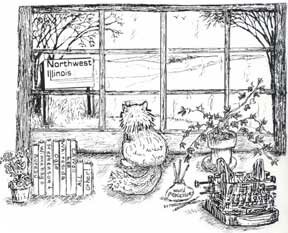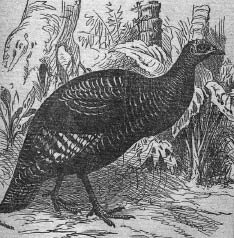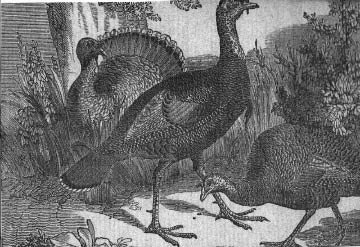
Discover rewarding casino experiences. 

Please Don't Quote Me |
It’s been in very recent decades that the regal, strutting turkey has again become the centerpiece of the Thanksgiving table and a part of our backyard bird watching. The turkey began to appear up in the JoDaviess hills and then wandered throughout the entire Northwest of Illinois. Although this year they’ve been scarce with their presence here in Lanark, we had a small group, varying in number for several years of which everyone would report their sightings and where they were roosting at night ... On whose back porch, of what stand of evergreens, their favorite hideout (and nesting place). Those sightings continued here for at least three years but this year they are hiding out somewhere and no reports have been made of the “Council,” as some called them. At one point a big tom was reported sitting on a desk at the city building but he was rounded up and transported elsewhere. Where are they now? We miss them. Turkeys are closely associated with Thanksgiving but if they were a main course at the first Harvest Home celebration in 1621 there’s argument. We can give any interpretation we want at this time in history. Wild turkeys have been domesticated for “home use” by the Aztecs even before any European set foot in the Americas. Record is found that exactly six hundred years ago Miguel de Passamoante, treasurer of the Indies, was ordered to bring several specimen of turkey to Spain and by 1519 they were a common sight there. They are such wanderers that by 1541 they were described in England. Maybe they had help in covering the miles?? There are two species of turkeys, both being gallanaceous meaning “chicken-like.” Other fowl being guinea and pea fowl, pheasant, quail, and so forth. One species is the ocellated (Meleager ocelata) that is found in the Yucatan Peninsula, parts of British Honduras and Guatemala where, it’s believed, they haven’t been domesticated. They are less than twenty pounds in weight and considered the more colorful of the turkey with brilliant colors and designs. The other is the Meleager gallopavo, the turkey we have throughout the United States, southern Canada and all of Mexico. The identity Meleager means speckled because over all those iridescent blues, greens, coppers, bronzings, there can be seen a speckled, dripping pattern as if an artist drizzled water over a wet canvas of work in progress. Despite their incredible beauty of body, they lost out in facial features, their heads and necks being “carunculated,” meaning naked flesh, garish red and lumpy.
The appendage hanging from beneath their chin is a wattle or dewlap in name while the loose flap on the top of the head is called a snood. In the male (tom or gobbler) the red is overlaid in whites and blues and the females are mostly red. The female is a hen and the young are called poults. The carunculated head/neck changes somewhat in color as the bird is aroused by an enemy or a possible love interest. A tuft of hairlike feathers on the throat can be seen also. Why the head is so ugly in comparison to the rest of its turkey body we don’t know except perhaps Mother Nature was attempting to keep the strutter humble, if possible. Early-arriving colonists brought the turkey with them thinking it was different from those found here but actually they were returning them to their native home. The Fowl of the Pilgrim was merely a distant relative of the other. And it became the symbol of Thanksgiving from Pilgrim times. The Meleager gallopaveo silvestris was the Eastern bird also found throughout the Midwest, Southwest and so forth. They exist in all climates, the hot, tropical regions and in elevations up to 8,500 feet of the Sierra Madre Mountains of California, somewhat surprising, don’t you think! Wild turkeys eat nuts, seeds, tubers, roots, fruits, leaf buds, legumes, grasses, even small amphibians, crustaceans and mollusks, so you see they are quite adaptable in the diet department thus able to live most everywhere. There are seven standard subspecies in the United States, they being such as the Bronze, Narragansett, White Holland, Bourbon, Black and Slate all of which were long bred for the perfection of their plumage color and “designs” in their feathers. Meat wasn’t necessarily an issue until “recent times.” The Native American did use the turkey for food although some tribes would not eat them because character traits were transported from the bird to the human. The turkey, when confronted by an enemy would run so the Indian eschewed the meat of the turkey for fear they’d be seen as cowardly. The feathers, however, were, naturally, used for various things like pieces of clothing. “They twist the inner web into a strong double string with hemp or the inner bark of the mulberry tree to work it like matting. This appears very rich and glossy as fine as silk shag. Natives of Louisiana make fans of the tail; Natives of Louisiana make fans of the tail; and of four tails put together, the French used formerly to construct a beautiful parasol.” So said an insert in an early twentieth century “History of Birds” with 500 spirited illustrations and graphic descriptions, (!!!)” a book in a large collection of bird books from late mother-in-law, Caroline Keefer Aschenbrenner, Amboy. While the illustration here is from that, too, the ocellated turkey weighs only about twenty pounds, the North American tom can top twice, two and a half times that amount. Up until 1935 the turkey’s meat was a secondary concern but then changes occurred in the turkey industry. With input from the British turkey breeders, they specializing in the Bronze, a new type evolved, the Broad Breasted Bronze, which continues to dominate the market. It plus the Beltsville Small White became a seventh subspecies with the long-time original six standard. The Beltsville was developed by the U.S. Department of Agriculture Cooperation between state experimental stations and private breeders, the “efficient” turkey has become an important part of the menu of the American and world’s people for its economy and nutritional value. Year ‘round consumption has occurred, not just the holidays, and increased use in the way of turkey specialties such as turkey rolls, ‘lunch meat,’ and other tasty items for sandwiches and casseroles, etc. Just in the last half century the turkey industry has grown steadily in the United Kingdom, Australia, the U.S. and somewhat in Latin America. In Carroll County alone there was Law’s Turkey Farm and Lanark Poultry House that processed the fowl. Turkey has become popular throughout Europe where in Russia, for instance, Scandinavia, Germany, etc., the roast turkey is the centerpiece of the Christmas table. In the United States the turkey is the icon of Thanksgiving celebrations ... Usually. It’s one tradition Americans like to preserve. Benjamin Franklin was such a proponent of having a “Native American” bird be used as for a symbol of our nation that he expounded lengthily on picturing the turkey instead of the bald eagle which won out, perhaps, because the turkey couldn’t soar dramatically or its gobble was not a pretty sound! Alexander Hamilton once said of it, “No citizen of the United States should refrain from having turkey on Thanksgiving,” that’s how far back its tradition goes. And you might be wondering just where the turkey got its name. Well, ‘way back in time or rather, too, not that long ago also, geography wasn’t very accurate and maps were scarce. Distant, exotic places were a vague idea so when, say, a rare bird was brought to the notice of the public, it was said to have come from Turkey, no matter what kind of bird it was. Eventually, some other name was given it except for THE turkey which because it is such a “rare” bird, deserves to be called Turkey for certain.
|





